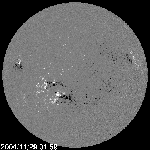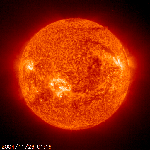|
|
|
 |
|
| Our Sun - NASA and other Space Based
Missions |
| |
| There are two NASA and NASA
ESA space-based satellite missions studying the Sun. |
| In addition, you may want to
check out
AeroSpaceGuide. This site has some interesting
facts as well as mission summaries. |
| SOHO:
http://sohowww.nascom.nasa.gov/ |
| The most popular mission is
the SOHO (SOlar and Heliospheric Observatory). This
orbiting satellite has provided some of the most
remarkable images of the Sun. There
are a number of specialized instruments on the SOHO spacecraft: |
 |
 |
| The above SOHO
image is taken by the MDI. |
This image is
also using the MDI, but emphasizes the sunspot
magnetic fields. |
 |
 |
| The LASCO image
above allows a view of the corona. The large
occlusion in the center is called an occultation
disk. |
This LASCO
image is of a wider field. The occultation disk is
in place. The circle within the disk is the diameter
of the Sun. |
| The following
images are taken with the EIT. The images are
focused at a particular
frequency which corresponds
to levels of atmosphere. The higher the
wavelength,
the higher up the atmosphere is imaged, and the
hotter the
temperature. |
 |
 |
| EIT Image at
171 angstroms - 1 million degrees |
EIT Image at
195 angstroms - 1.5 million degrees |
 |
 |
| EIT Image at
284 angstroms - 2 million degrees |
EIT Image at
304 - this image is focused more towards the surface
- 60,000 to 80,000 degrees |
|
Nearly all of these
experiments cannot be performed here on
Earth. The
atmosphere safely filters out the Ultraviolet - the
primary wavelength observed by SOHO - and the
gravity oscillations are better studies in space
without the contamination of oscillations present on
Earth (like earthquakes, traffic jams and so on). |
The Ulysses:
http://ulysses.jpl.nasa.gov/
|
| In its 12 year mission, the
Ulysses studied the solar maximum conditions as well
as studies of the polar regions to better understand
the solar atmosphere (the photosphere and
chromosphere).
The mission of the Ulysses spacecraft has been
extended until 2008.
|
| Primary mission results (care
of
http://ulysses.jpl.nasa.gov/) |
| Solar Wind Speed from North and South
Poles |
 |
The Solar Winds emanating from the polar
regions of the Sun are faster than the equatorial
regions - around 800 km/s for the poles and 600 km/s
for the equator. |
| Solar Magnetic Field Strength |
 |
The strength of the magnetic field
increases towards the polar regions of the Sun. |
| Different Compositions between Fast and
Slow streams |
 |
The ratio of Mg/O (Mg = magnesium, O =
oxygen) are larger in low speed solar winds.
Additionally, the amount of Mg/O is lower in faster
speed solar winds. This means the
temperature of the chromosphere is affecting the ionization of the
elements thereby affecting the
temperature of the
corona. |
| Cosmic Rays diffused in the Heliosphere |
 |
Cosmic rays are thought to travel along
magnetic field lines. Since the magnetic fields from
the Sun are strongest near the poles, it was thought
that cosmic rays would be greater in these regions.
Ulysses discovered no such increase. |
Back to Top
|
|

